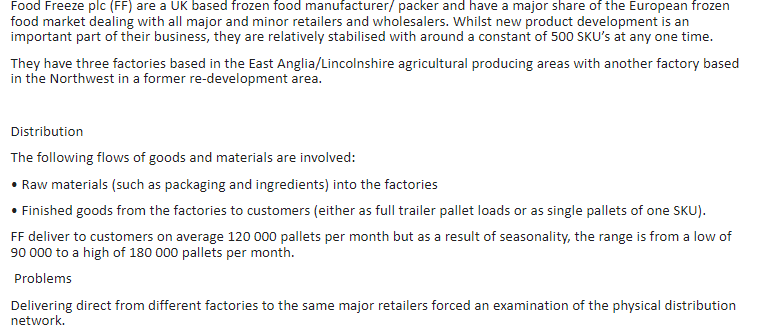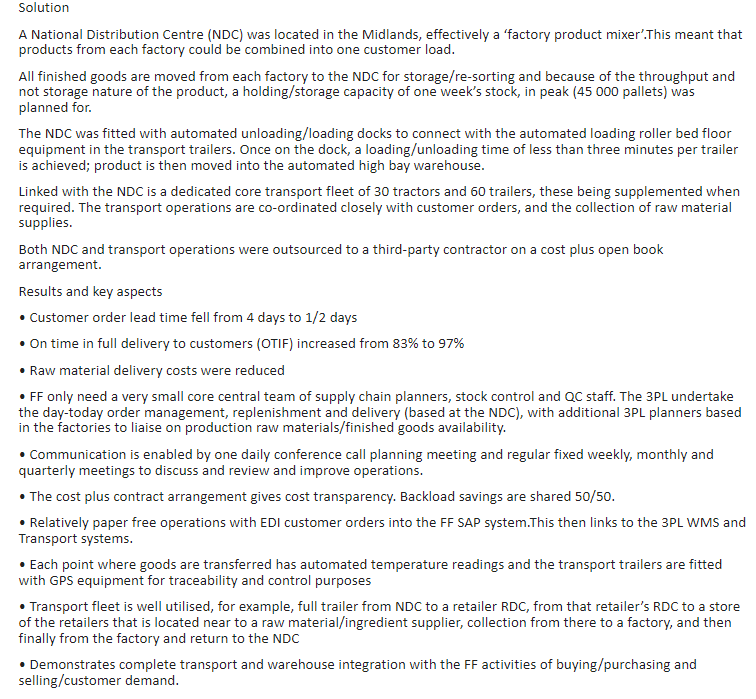1. Explain how demand influences the warehouse processes.
2. What model can they adopt for planning inventory?


Food Freeze plc (FF) are a UK based frozen food manufacturer/ packer and have a major share of the European frozen food market dealing with all major and minor retailers and wholesalers. Whilst new product development is an important part of their business, they are relatively stabilised with around a constant of 500 SKU's at any one time. They have three factories based in the East Anglia/Lincolnshire agricultural producing areas with another factory based in the Northwest in a former re-development area. Distribution The following flows of goods and materials are involved: - Raw materials (such as packaging and ingredients) into the factories - Finished goods from the factories to customers (either as full trailer pallet loads or as single pallets of one SKU). FF deliver to customers on average 120000 pallets per month but as a result of seasonality, the range is from a low of 90000 to a high of 180000 pallets per month. Problems Delivering direct from different factories to the same major retailers forced an examination of the physical distribution network. Solution A National Distribution Centre (NDC) was located in the Midlands, effectively a 'factory product mixer'. This meant that products from each factory could be combined into one customer load. All finished goods are moved from each factory to the NDC for storage/re-sorting and because of the throughput and not storage nature of the product, a holding/storage capacity of one week's stock, in peak (45 000 pallets) was planned for. The NDC was fitted with automated unloading/loading docks to connect with the automated loading roller bed floor equipment in the transport trailers. Once on the dock, a loading/unloading time of less than three minutes per trailer is achieved; product is then moved into the automated high bay warehouse. Linked with the NDC is a dedicated core transport fleet of 30 tractors and 60 trailers, these being supplemented when required. The transport operations are co-ordinated closely with customer orders, and the collection of raw material supplies. Both NDC and transport operations were outsourced to a third-party contractor on a cost plus open book arrangement. Results and key aspects - Customer order lead time fell from 4 days to 1/2 days - On time in full delivery to customers (OTIF) increased from 83% to 97% - Raw material delivery costs were reduced - FF only need a very small core central team of supply chain planners, stock control and QC staff. The 3PL undertake the day-today order management, replenishment and delivery (based at the NDC), with additional 3PL planners based in the factories to liaise on production raw materials/finished goods availability. - Communication is enabled by one daily conference call planning meeting and regular fixed weekly, monthly and quarterly meetings to discuss and review and improve operations. - The cost plus contract arrangement gives cost transparency. Backload savings are shared 50/50. - Relatively paper free operations with EDI customer orders into the FF SAP system.This then links to the 3PL WMS and Transport systems. - Each point where goods are transferred has automated temperature readings and the transport trailers are fitted with GPS equipment for traceability and control purposes - Transport fleet is well utilised, for example, full trailer from NDC to a retailer RDC, from that retailer's RDC to a store of the retailers that is located near to a raw material/ingredient supplier, collection from there to a factory, and then finally from the factory and return to the NDC - Demonstrates complete transport and warehouse integration with the FF activities of buying/purchasing and selling/customer demand. Food Freeze plc (FF) are a UK based frozen food manufacturer/ packer and have a major share of the European frozen food market dealing with all major and minor retailers and wholesalers. Whilst new product development is an important part of their business, they are relatively stabilised with around a constant of 500 SKU's at any one time. They have three factories based in the East Anglia/Lincolnshire agricultural producing areas with another factory based in the Northwest in a former re-development area. Distribution The following flows of goods and materials are involved: - Raw materials (such as packaging and ingredients) into the factories - Finished goods from the factories to customers (either as full trailer pallet loads or as single pallets of one SKU). FF deliver to customers on average 120000 pallets per month but as a result of seasonality, the range is from a low of 90000 to a high of 180000 pallets per month. Problems Delivering direct from different factories to the same major retailers forced an examination of the physical distribution network. Solution A National Distribution Centre (NDC) was located in the Midlands, effectively a 'factory product mixer'. This meant that products from each factory could be combined into one customer load. All finished goods are moved from each factory to the NDC for storage/re-sorting and because of the throughput and not storage nature of the product, a holding/storage capacity of one week's stock, in peak (45 000 pallets) was planned for. The NDC was fitted with automated unloading/loading docks to connect with the automated loading roller bed floor equipment in the transport trailers. Once on the dock, a loading/unloading time of less than three minutes per trailer is achieved; product is then moved into the automated high bay warehouse. Linked with the NDC is a dedicated core transport fleet of 30 tractors and 60 trailers, these being supplemented when required. The transport operations are co-ordinated closely with customer orders, and the collection of raw material supplies. Both NDC and transport operations were outsourced to a third-party contractor on a cost plus open book arrangement. Results and key aspects - Customer order lead time fell from 4 days to 1/2 days - On time in full delivery to customers (OTIF) increased from 83% to 97% - Raw material delivery costs were reduced - FF only need a very small core central team of supply chain planners, stock control and QC staff. The 3PL undertake the day-today order management, replenishment and delivery (based at the NDC), with additional 3PL planners based in the factories to liaise on production raw materials/finished goods availability. - Communication is enabled by one daily conference call planning meeting and regular fixed weekly, monthly and quarterly meetings to discuss and review and improve operations. - The cost plus contract arrangement gives cost transparency. Backload savings are shared 50/50. - Relatively paper free operations with EDI customer orders into the FF SAP system.This then links to the 3PL WMS and Transport systems. - Each point where goods are transferred has automated temperature readings and the transport trailers are fitted with GPS equipment for traceability and control purposes - Transport fleet is well utilised, for example, full trailer from NDC to a retailer RDC, from that retailer's RDC to a store of the retailers that is located near to a raw material/ingredient supplier, collection from there to a factory, and then finally from the factory and return to the NDC - Demonstrates complete transport and warehouse integration with the FF activities of buying/purchasing and selling/customer demand








